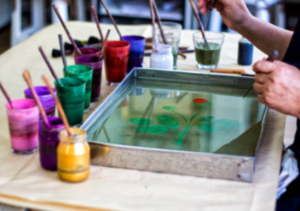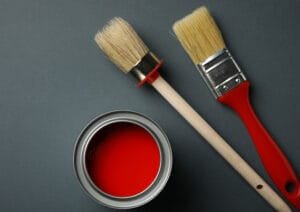Introduction to Decorative Coatings
Mithila Paints, also known as Mithila Art or Madhubani Paintings, originate from the Mithila region of Bihar, India. This traditional art form, deeply rooted in the cultural heritage of the area, dates back to several centuries. Local artisans have been practicing this craft, using natural materials and traditional techniques passed down through generations. Mithila Paints are typically created with a variety of natural pigments derived from plants, minerals, and even cow dung, which reflect the rich environment and biodiversity of the region.
The motifs and themes prevalent in Mithila art are deeply symbolic, often depicting daily life, nature, mythology, and spiritual beliefs. Common subjects include gods, goddesses, animals, and natural elements, each carrying significant cultural meanings. The use of intricate patterns, geometric designs, and vivid imagery enhances the visual appeal of Mithila Paints, making them not just a decorative choice but a narrative form that represents the ethos of Mithila’s people.
Color plays a crucial role in Mithila paintings, with artisans employing a vibrant palette that encompasses shades of red, green, yellow, blue, black, and white. These colors are derived from natural sources such as turmeric, indigo, and various leaves, emphasizing the community’s connection to their environment. The application of these colors is often layered and meticulous, with artists using brushes fashioned from twigs to create fine lines and complex designs.
Understanding Mithila Paints is essential to appreciating their cultural significance. They offer a glimpse into the rich traditions and values of the Mithila region, demonstrating that these paints are more than mere decorative coatings — they are a living expression of a vibrant cultural legacy.
The Art of Decorative Coatings
Decorative coatings are specialized layers applied to surfaces to enhance their aesthetic appeal, often functioning as both protective and decorative elements in various applications. These coatings are utilized in crafting and interior design to transform ordinary spaces into visually captivating environments. By incorporating unique designs, textures, and colors, decorative coatings offer individuals an avenue to express their personal style and creativity.
Mithila paints, a vivid and intricate art form originating from the Mithila region of India, serve as an excellent example of a decorative coating that embodies cultural richness and artistic expression. Traditionally used on walls, floors, and roofs, Mithila paintings are now adapted for various surfaces, including canvases, furniture, and business interiors. Employing natural dyes, these paints produce vibrant hues that not only reflect the artist’s vision but also resonate with the cultural heritage from which they emerge.
The application of Mithila paints as decorative coatings presents a plethora of benefits. Firstly, these coatings significantly enhance the aesthetic appeal of any space, providing an artistic touch that can uplift the ambiance of even the simplest settings. Furthermore, Mithila paints allow for personal expression; individuals can choose designs that resonate with their identities, values, or emotions, creating spaces that are relatable and meaningful.
Moreover, the durability of Mithila coatings is an essential attribute. Made from natural substances, these decorative paints are not only eco-friendly but also resistant to wear and tear, ensuring that the beauty of the artwork endures over time. This longevity makes Mithila paints a cherished choice for both artisans and homeowners who seek lasting decorative solutions. In this way, Mithila paints exemplify the convergence of artistry and functionality in decorative coatings, making them an invaluable addition to contemporary design practices.

Essential Tools and Materials for Crafting
Crafting with Mithila paints requires a careful selection of tools and materials to achieve the best results. Whether you are a beginner or an experienced artist, having the right equipment can significantly enhance the quality and precision of your work. The fundamental tools include a variety of brushes, each serving distinct purposes, such as fine-tipped brushes for intricate details and broader brushes for filling larger areas. Natural bristle brushes are often favored for their ability to hold paint effectively, allowing for smoother strokes. Additionally, sponges are valuable for creating textured effects and achieving variations in paint application.
Surfaces suitable for painting are equally critical. Mithila paintings can be effectively executed on diverse materials such as canvas, paper, wood, and even fabric. The selection of the surface largely depends on the intended project; for instance, canvas is ideal for large artworks, while paper is more suitable for smaller, detailed pieces. Each surface type may require specific preparation, including priming or stretching, to ensure optimal adhesion and durability of the paint.
Another essential component of your crafting kit is a palette, which is instrumental in mixing colors and ensuring a well-blended application. While disposable palettes are convenient, investing in a reusable palette can provide better control over the paint consistency. Additionally, a container for water is essential when working with water-based Mithila paints, facilitating easy cleanup and maintaining brush quality.
Finally, do not overlook the importance of high-quality materials in your painting endeavors. Using premium-grade paints, brushes, and surfaces can significantly impact the vibrancy and longevity of your artwork. Prioritize sourcing Mithila paints that are rich in pigments and have a reliable finish. By equipping yourself with these essential tools and materials, you will be well-prepared to unleash your creativity and fully enjoy the process of crafting with Mithila paints.

Techniques for Applying Mithila Paints
Mithila painting, a traditional art form originating from the Mithila region of Bihar, India, offers a myriad of techniques for application that enhances the beauty and intricacy of its designs. One of the primary methods is brushwork, where fine brushes are utilized to create detailed patterns and intricate motifs. This technique allows for a wide range of expressions, from delicate strokes to bold outlines, making it essential for achieving the characteristic intricacies of Mithila art. When attempting brushwork, it is advisable to select brushes of varying sizes to accommodate different details within the artwork.
Stenciling is another effective method for applying Mithila paints, particularly suitable for those who may be new to this art form. This technique involves the use of pre-prepared templates that one can place on the desired surface to guide the application of paint. Stenciling helps in creating uniform patterns and is excellent for producing repeat designs across larger surfaces. For optimal results, ensure that the stencil is secured properly to prevent any paint bleed, thereby maintaining the crispness of each design.
Layering is a vital technique when employing Mithila paints, as it helps build depth and richness in color. By applying multiple layers of paint, artists can create stunning visual effects and achieve a vibrant finish. It is crucial to allow each layer to dry completely before applying the next, to avoid smudging and ensure clarity in the designs. Additionally, maintaining a consistent application pressure and brush angle can further enhance the overall visual fidelity of the artwork.
For those seeking to replicate the traditional and intricate designs typical of Mithila art, patience and practice are key. Combining these techniques effectively will not only enhance your artistic skills but also allow you to appreciate the rich cultural heritage embodied in Mithila painting. Ultimately, experimenting with different techniques will empower artists to unleash their creativity while staying true to the essence of this beautiful art form.

Inspiration from Traditional Mithila Motifs
Mithila painting, an age-old tradition hailing from the Mithila region of Bihar, India, features a vibrant array of motifs that are deeply symbolic and culturally significant. Each design is a narrative, reflecting the beliefs, values, and customs of the local community. While the motifs may vary, some are particularly popular and have transcended time, influencing various forms of decorative arts and crafts.
Among the most recognized motifs are peacocks, which symbolize grace and beauty. In Mithila paintings, peacocks often represent the arrival of the monsoon and the joy it brings. This imagery can be seamlessly integrated into modern crafting projects, such as wall art or fabric design, allowing creators to imbue their works with a sense of natural elegance and serenity.
Another compelling motif is the elephant, regarded as a symbol of wisdom and strength. Elephants often appear in folk tales and celebrations, making them perfect embellishments for decorative items intended for joyful occasions. Craft enthusiasts can draw inspiration from these majestic creatures to create ornamental pieces that signify good fortune and prosperity in their home decors.
Floral patterns are equally significant, portraying growth, fertility, and the interconnectedness of life. These intricate designs not only enhance the aesthetic appeal of any project but also serve as a reminder of the beauty found in nature. By incorporating floral motifs into crafts, individuals can express their unique interpretations of growth and abundance, making each piece a representation of personal storytelling.
As you explore the world of Mithila painting, look for inspiration in your own surroundings or personal narratives. Nature, family heritage, and even life experiences can provide a rich source of ideas that resonate with traditional motifs, allowing for the creation of truly unique decorative pieces.

Step-by-Step Projects Using Mithila Paints
Mithila paints, known for their vibrant colors and intricate designs, offer an exciting avenue for creative expression through various crafting projects. Here, we provide detailed instructions for three distinct projects that cater to differing skill levels: decorative wall art, hand-painted furniture, and festive decorations.
Project 1: Decorative Wall Art
Begin by selecting a canvas or wooden board as your base. Use a pencil to sketch your desired design lightly, drawing inspiration from traditional Mithila motifs such as flora, fauna, or geometric patterns. Once satisfied with your sketch, fill in the outlines using Mithila paint, focusing on bold colors to create a striking visual effect. Allow the first layer to dry and continue layering with further details and decorative elements. For a polished finish, consider applying a protective clear varnish once everything is dry.
Project 2: Hand-Painted Furniture
Transforming furniture pieces using Mithila paints can add a unique flair to your home décor. Start with a plain or previously painted item made from wood. Clean the surface thoroughly, then apply a base coat if necessary. After this dries, sketch your design and proceed to paint, utilizing bright colors and traditional patterns. This can include border designs or centerpieces. Allow the piece to dry, and finish with a sealant to protect your artwork from wear and tear.
Project 3: Festive Decorations
For seasonal celebrations, Mithila painted decorations make striking additions. Take a set of plain candles or jars; these can serve as a canvas for your creativity. Sketch festive-themed motifs, like peacocks or flowers, customizing them according to the occasion. Use vibrant Mithila paint to bring these designs to life. Once dry, these decorative pieces can enhance your festive ambiance, showcasing the beauty of your creativity while adhering to traditional art forms.
In conclusion, through these step-by-step projects utilizing Mithila paints, individuals of varying skill levels can harness their creativity and personalize their surroundings. Embracing these painting techniques not only enhances artistic skills but also allows for cultural appreciation and expression.

Caring for Your Decorative Coatings
Proper care and maintenance of surfaces painted with Mithila paints are essential in ensuring the longevity and vibrancy of your decorative coatings. The unique characteristics of Mithila art, which often involve intricate designs and vivid colors, require specific techniques for cleaning and upkeep. Regular care not only retains the aesthetic appeal but also protects the underlying surface.
When it comes to cleaning Mithila-painted surfaces, gentle methods are highly recommended. It is best to use a soft, damp cloth to wipe the painted area, avoiding abrasive materials that could dull or scratch the artwork. If residue or dust persists, a mild soap solution can be applied with a soft sponge. After cleaning, it is crucial to dry the surface thoroughly with another clean, dry cloth to prevent moisture damage.
Protecting your Mithila paints from environmental factors also plays a significant role in their preservation. Extreme temperatures and direct sunlight can cause fading and deterioration over time. It is advisable to keep painted items indoors or shield them from direct sunlight when displayed outside. Additionally, applying a protective sealant appropriate for the type of paint used can help create a barrier against moisture and dust, thus prolonging the life of the decorative coatings.
Despite taking precautionary measures, common issues may still arise, such as chipping or peeling of paint. In such cases, it is essential to address repairs promptly. Minor chips can be retouched with matching paint, while larger areas may benefit from a full repainting. The key is to ensure that any repairs blend seamlessly with the existing artwork, preserving the overall integrity of the decorative coatings.
Ultimately, through proper cleaning, protection, and timely repairs, you can maintain the beauty and charm of Mithila-painted surfaces, allowing your decorative coatings to be enjoyed for years to come.

Eco-Friendly Aspects of Mithila Painting
Mithila painting, an ancient tradition originating from the Mithila region of India, is celebrated not only for its intricate designs and vibrant colors but also for its ecological consciousness. The paints used in Mithila art are derived from natural ingredients, thus posing minimal risk to the environment. This sustainable approach encapsulates the essence of eco-friendly crafting by employing materials like vegetable dyes, which are safe and biodegradable.
Traditional artisans typically source pigments from plants, fruits, and minerals, ensuring that their craft resonates with the principles of sustainability. For instance, colors may be extracted from indigo for blue, turmeric for yellow, and soot for black, providing a wide spectrum of hues while maintaining a zero-waste philosophy. The absence of synthetic components eliminates the harmful chemical footprint that is often associated with conventional paints, thereby making Mithila paintings a prudent choice for environmentally conscious consumers.
The techniques and methods honed over generations further emphasize the cultural heritage which aligns with eco-friendly practices. These artists do not just produce art; they create it in harmony with nature. The tools utilized in the process, such as handmade brushes crafted from natural fibers, also enhance the green credentials of Mithila painting. By fostering a deep connection with the environment, artisans are not only preserving their ancestral skills but also promoting a sustainable lifestyle.
In today’s age, where climate change and environmental degradation pose significant challenges, the significance of choosing sustainable products cannot be overstated. Opting for Mithila paints reflects a commitment to mindful living and the preservation of traditional artistry. This approach encourages individuals to not only appreciate the beauty of Mithila art but also to acknowledge their role in fostering an environmentally sustainable future. The crafts of Mithila paint thus serve as a powerful reminder of how art and nature can coexist harmoniously while nurturing both creativity and sustainability.
Conclusion and Call to Action
In this comprehensive guide to Mithila paints, we have explored the rich heritage and artistic intricacies of this traditional Indian art form. Mithila paintings are not merely decorative; they reflect cultural narratives, folklore, and an elegant charm that transcends time. The versatility of Mithila paints allows them to adapt seamlessly to various decorative coating projects, enhancing both residential and commercial spaces alike. Their vibrant colors and intricate designs can breathe life into any surface, ensuring that your crafting endeavors stand out.
The journey of creativity with Mithila paints is an invitation to delve deep into your artistic abilities. Whether you are a novice or an experienced artist, engaging with Mithila artistry can provide you with a unique platform to express your individuality. Embrace the freedom of experimentation by combining traditional motifs with contemporary ideas, thus cultivating a truly distinctive style. Furthermore, as you embark on this creative path, remember to document and share your Mithila-inspired projects across social media platforms. This sharing not only showcases your talents but also contributes to a broader community of fellow enthusiasts passionate about decorative crafts.
We encourage you to take the plunge into the captivating world of Mithila paints. Explore their myriad applications, engage with the cultural stories they tell, and allow your creativity to flourish. Each stroke of paint can serve as a connection to a rich tradition and a medium for personal expression. Join us in celebrating the beauty of Mithila artistry by creating your own masterpieces and fostering a community that thrives on shared inspiration and creativity. Let your imagination guide you, and may your decorative projects be both fulfilling and transformative.


